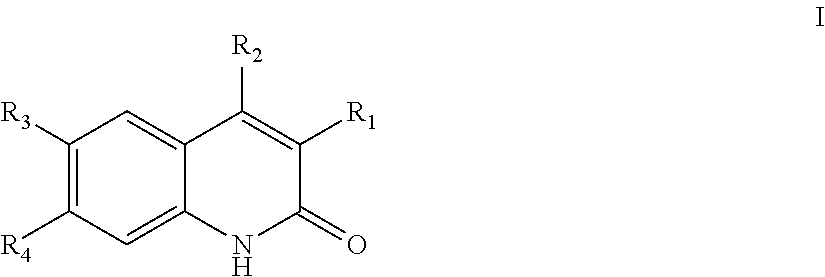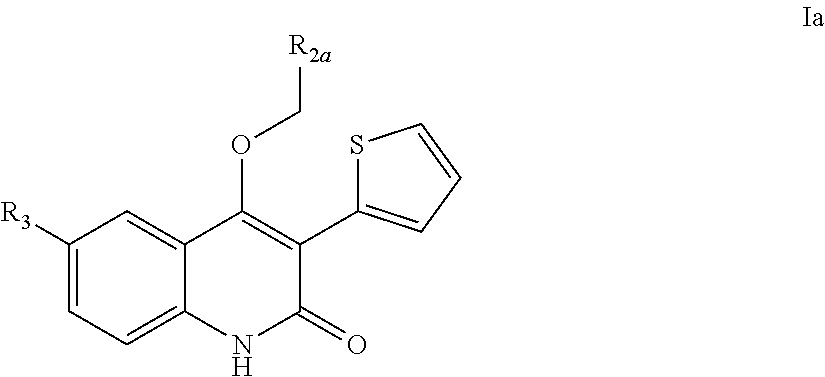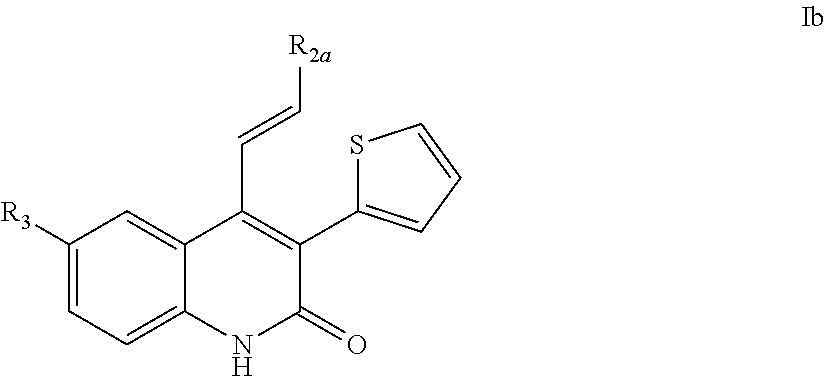Quinolinone PDE2 inhibitors
a technology of quinolinone and pde2, which is applied in the field of compounds, can solve the problems of high noncomplicance or discontinuation rate of medication, lack of efficacy, and dissatisfaction with therapy
- Summary
- Abstract
- Description
- Claims
- Application Information
AI Technical Summary
Benefits of technology
Problems solved by technology
Method used
Image
Examples
example 1-57
4-(tetrahydro-2H-pyran-4-ylmethoxy)-6-(3-hydroxy-3-methylbut-1-yn-1-yl)-3-(thiophen-2-yl)quinolin-2(1H)-one
[0164]
Step 1: Methyl 5-bromo-2-[(4-methoxybenzyl)amino]benzoate
[0165]
[0166]To a solution of methyl 2-amino-5-bromobenzoate (10.0 g, 43.5 mmol) in dichloromethane (0.5 M, 90 mL) at 0° C. were added p-anisaldehyde (7.9 mL, 65 mmol) and acetic acid (1.2 mL, 22 mmol). Sodium triacetoxyborohydride (18.4 g, 87.0 mmol) was added portion-wise to the solution mixture. The reaction was allowed to warm to room temp and stirred overnight. Upon completion, the reaction was poured into saturated sodium bicarbonate (200 mL). The product was extracted with dichloromethane (3×75 mL). The combined organic extractions were dried over magnesium sulfate, filtered, and concentrated in vacuo. The crude material was purified via flash chromatography (silica, 1:1 hexanes / dichloromethane) to yield methyl 5-bromo-2-[(4-methoxybenzyl)amino]benzoate. HRMS (M+H)=350.0381. 1H NMR (400 MHz, CDCl3) 8.08 (b, 1H...
example 1-51
6-bromo-4-[(E / Z)-2-(pyridine-2-yl)ethenyl]-3-(thiophen-2-yl)quinolin-2(1H)-one
[0176]
Step 1: 6-bromo-2-oxo-3-(thiophene-2-yl)-1,2-dihydroquinoline-4-carboxylic acid
[0177]
[0178]To a flask containing 2-thiophene acetic acid (3.08 g, 21.7 mmol) at 150° C. were added sodium acetate (0.25 g, 3.1 mmol) and 7-bromoisatin (2.80 g, 12.4 mmol). The reaction was allowed to stir at elevated temperatures for 1 h. The reaction was cooled to room temperature and diluted with ethanol (50 ml). The reaction was placed in an ice bath for 30 min. The product was collected by filtration and rinsed with cold ethanol (20 ml). The beige solid was dried in vacuo to afford 6-bromo-2-oxo-3-(thiophene-2-yl)-1,2-dihydroquinoline-4-carboxylic acid. Compound used without further purification. LCMS (M+H)=3513.
Step 2: 6-bromo-4-(hydroxymethyl)-3-(thiophen-2-yl)quinolin-2(1H)-one
[0179]
[0180]To a solution containing 6-bromo-2-oxo-3-(thiophene-2-yl)-1,2-dihydroquinoline-4-carboxylic acid (1.00 g, 2.86 mmol) in tetrahyd...
example 1-80
6,7-dimethoxy-4-[3-(pyridin-4-yl)phenyl]-3-(thiophen-2-yl)quinolin-2(1H)-one
[0185]
Step 1: 2-bromo-4,5-dimethoxyaniline
[0186]
[0187]To a solution of 3,4-dimethoxybenzenamine (20.0 g, 0.130 mol) in dry THF (200 mL) was added concentrated H2SO4 (20 drops) under N2 at −78° C. After 10 mains, NBS (23.2 g, 0.130 mol) was added in potions at −78° C. Then the reaction mixture was allowed to gradually warm up to room temperature over 1 hour. THF was removed under reduced pressure. The residue was diluted with EtOAc (200 mL), and washed with water (80 mL×3). The organic layer was dried over anhydrous MgSO4, filtered and concentrated in vacuum. The residue was purified by silica gel column (15:1 hexanes / ethyl acetate) to afford 2-bromo-4,5-dimethoxyaniline as a yellow solid. MS (M+H)=232 and 234.
Step 2: N-(2-bromo-4,5-dimethoxyphenyl)-2,2-dimethylpropanamide
[0188]
[0189]A dry 500 mL three-necked flask was charged with 2-bromo-4,5-dimethoxyaniline (23.4 g, 0.10 mol) and t-BuOMe (200 mL), NaOH (25...
PUM
| Property | Measurement | Unit |
|---|---|---|
| temperature | aaaaa | aaaaa |
| temperature | aaaaa | aaaaa |
| catalytic domain homology | aaaaa | aaaaa |
Abstract
Description
Claims
Application Information
 Login to View More
Login to View More - R&D
- Intellectual Property
- Life Sciences
- Materials
- Tech Scout
- Unparalleled Data Quality
- Higher Quality Content
- 60% Fewer Hallucinations
Browse by: Latest US Patents, China's latest patents, Technical Efficacy Thesaurus, Application Domain, Technology Topic, Popular Technical Reports.
© 2025 PatSnap. All rights reserved.Legal|Privacy policy|Modern Slavery Act Transparency Statement|Sitemap|About US| Contact US: help@patsnap.com



